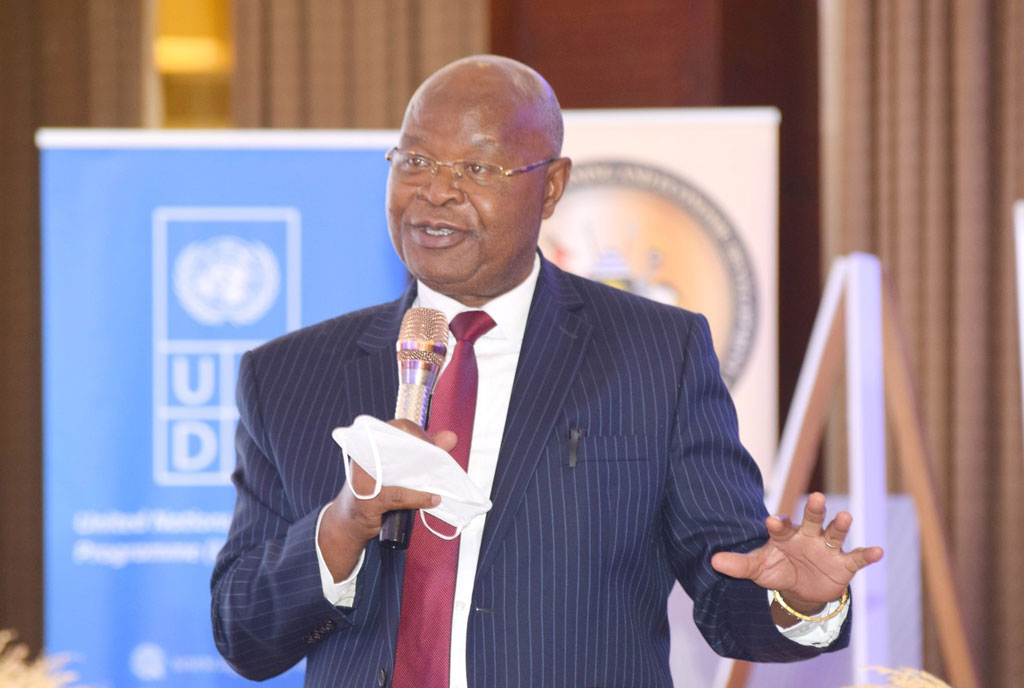Indoor spraying keeps away malaria

Fight against malaria. A government official launches the IRS programme in Dokolo District recently. PHOTO BY ISAAC OTWII
What you need to know:
- In 2016, malaria caused an estimated 216 million clinical episodes, and 445,000 deaths worldwide, according to World Health Organisation.
- An estimated 91 per cent of deaths in 2016 were in Africa. Every year, Uganda registers more than 100,000 malaria deaths. The African region continues to bear 90 per cent of malaria cases.
DOKOLO/APAC. Ms Kato Otim experienced vaginal bleeding during the first 12 weeks of her pregnancy. The mother of two and a resident of Nambieso Sub-County in Apac District had also complained of abdominal pains.
On February 28, 2018, her husband, Mr Felix Otim, rushed her to a private health facility in Lira town where doctors detected she was actually suffering from a threatening abortion.
Unfortunately, on March 2, the 31-year-old woman suffered a miscarriage and was immediately transferred to Lira Regional Referral Hospital for post-abortion care before being discharged on March 4.
“I missed my period around December 2017 and when I went for medical check-up they told me that I was pregnant. On receiving the good news, I became so happy because my three children were impatiently waiting for me to produce another baby girl,” says Ms Otim.
Kato recalls that before the miscarriage she was on treatment for malaria for four days.
Symptoms of malaria include fever and flu-like illness, including chills that cause shaking, headache, muscle aches, and tiredness. Nausea, vomiting, and diarrhoea may also occur. Malaria may cause anaemia and jaundice (yellow colouring of the skin and eyes) because of the loss of red blood cells. If not promptly treated, the infection can become severe and may cause kidney failure, seizures, mental confusion, coma and death.
“I had just completed treatment when I started experiencing vaginal bleeding,” Ms Otim says, adding that she spent over Shs200,000 to treat malaria during her pregnancy.
Kato’s experience is a reflection of substantial costs malaria imposes to individuals.
Centers for Disease Control and Prevention says in areas with high transmission, the most vulnerable groups are young children, who have not developed immunity to malaria yet, and pregnant women, whose immunity has been decreased by pregnancy.
World Health Organisation’s World Malaria Report 2013 estimated that 3.2 billion people (half the world’s population) live in areas at risk of malaria transmission in 106 countries and territories.
In 2016, malaria caused an estimated 216 million clinical episodes, and 445,000 deaths. An estimated 91% of deaths in 2016 were in the WHO African Region.
According to Uganda National Malaria Control Programme, malaria is the cause of the third highest number of deaths. Every year, Uganda registers more than 100,000 malaria deaths and about 46 million cases are diagnosed with the disease both in public and private health facilities.
To eliminate malaria, the government of Uganda has come up with several interventions including the use of Indoor Residual Spraying (IRS).
IRS is the application of insecticide to the inside of dwellings, on walls and other surfaces that serve as a resting place for malaria-infected mosquitoes. IRS kills mosquitoes when they come in contact with treated surfaces, preventing disease transmission.
For the intervention to be effective, the following conditions must apply:
Majority of vectors (that is, organisms that transmit malaria) must feed and rest indoors, vectors should be susceptible to the insecticide in use, houses should have “sprayable” surfaces, and a high proportion of the houses in target areas (more than 80 per cent) should be sprayed.
Dokolo District has been implementing the intervention since 2013 and authorities say IRS is having an impressive result in the district.
Dr Samuel Ojok, the District Health Officer, says five years ago, malaria contributed to 53 per cent of all the cases received at the Out Patient Departments, with children the most affected. It was also contributing to big number of Out Patient Department attendance, admissions, blood transfusions and spontaneous abortions, he says.
After delivery of IRS to Dokolo in 2013, considerable progress has been made in reducing malaria cases.
The district has reported a reduction of 3,200 cases of malaria due to IRS.
Malaria weekly reported cases in Dokolo reduced from an average of 3,500 cases per week in 2014 to less than 300 cases per week at the end of year 2017, according to 2017 Health Monitoring Information System (HMIS) report.
Implementation
The district information officer, Mr Suwed Musafiri, says the IRS intervention was conceived in 2012 following a council resolution.
“Before the implementation of the programme, council sat and made a resolution which was sent to the ministry of Health. That time, Dokolo was almost having the highest prevalence of malaria in the whole country,” he said.
“We were not doing well. We had lots of issues – children dropping out of school, children dying and mothers have miscarriages,” he added.
After the council resolution, a document was drafted and sent to the ministry of Health. It was approved and funding was sought from USAID as the lead funder and other consortiums like UKAID, President’s Malaria Initiative and Centers for Disease Control (CDC).
The district then started implementing the IRS programme in 2013, Mr Musafiri said.
Today, the total IRS coverage for the entire 11 sub counties including one town council in Dokolo stands at 86 per cent.
The district chairman, Mr Frederick Odongo, said they have been successful in the fight against malaria because everybody was involved.
“Before we started implementing IRS, we mobilised and sensitised the community and we set targets of what we expect from the pump operators. Where there is resistance, we normally go there and dialogue with the community and they understand and allow their houses to be sprayed,” Mr Odongo said.
By the end of the programme, the district expects 90 per cent coverage. The initiative is to protect more than 180,000 people at high risk between 2014 and 2022.
Challenges
Since there is no achievement without any challenge, Mr Odongo acknowledged the initiative has met resistance in Okwalongwen and Batta sub counties where farmers still think that IRS will contaminate their organic products. Currently, the IRS coverage in the two sub counties stands at 73 per cent.
“We managed to talk to them and they accepted to allow us spray their houses and we expect to begin the exercise next week,” he said. This was on…
Dokolo seems to be the only district registering a good amount of success. Because in spite of the intervention, three of the former 10 IRS districts in northern Uganda (Gulu, Lamwo and Kitgum) reported an increase in malaria cases to the National Malaria Control Programme (NMCP), Ministry of Health, according to Uganda Malaria Quarterly Bulletin Issue 10: April – June 2015.
Also, a review of the weekly surveillance data received from the 10 former IRS intervention districts (Apac, Kole, Gulu, Amuru, Nwoya, Pader, Agago, Kitgum, Oyam and Lamwo) indicated that there were upsurges in weekly malaria cases reported beyond the average threshold.
NMCP said the number of monthly malaria cases diagnosed (lab confirmed and clinical) and malaria incidence rapidly doubled in quarter II of 2015 from the lowest (829,548) recorded in over two years to the highest (1,629,237) since July 2013.
A similar trend occurred among children under five years; the numbers doubled from 238,961 cases by end of March 2015 to over 500,000 cases by June 2015.
NMCP attributed this surge in malaria burden to seasonality, drop in intervention coverage, especially IRS and long lasting insecticide treated mosquito nets and inadequate malaria-related behaviour change communication.
Partners involved
However, Dokolo presents a good picture. President Yoweri Museveni recently thanked the development partners who have contributed to the malaria fight, like the US and UK governments, the World Health Organisation and the Global Fund.
“When you talk of malaria, you are talking of two living organisms. One is an insect and another is a protozoa. The insect is the mosquito, the protozoa is the plasmodium. Unlike some of the other biological enemies we have, these are killable, you can kill them both,” the President said.
However, Mr Museveni noted that to eliminate malaria, it needs more effort than vaccination. “We need to kill the mosquito, how? By using treated bed nets, through residual indoor spraying every six months and outdoor spraying,” he said. Dokolo has so far proved that these interventions when well pursued can work.



